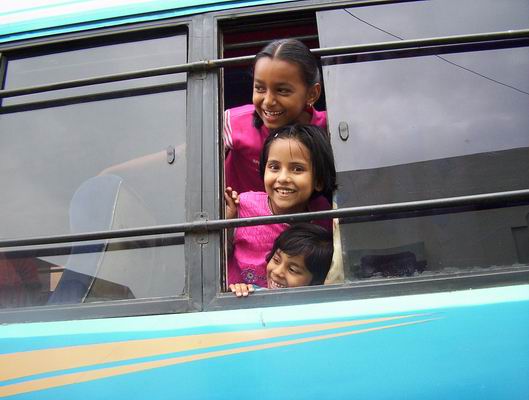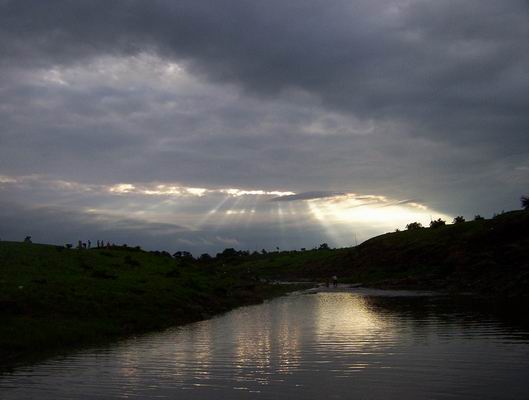
Some Tips for better photography with Digital Cameras.
Recently, I attended a digital photography workshop conducted by renowned, ace photographer Gurdas Dua. Gurdas Dua has won several national and international photography awards and is involved in professional photography since last 20 years. He is the only photographer in entire MP and Chattisgarh who is using large format CINAR camera. He has also written several articles in many eminent photography magazines. Some advertisement campaign with Dua's photographs became instant hit - that includes campaign of Egg-Coordination Committee, in which, an egg was depicted as computer mouse! How marvelous an idea and, equally, how marvelous photograph.
- Let me share some tips that I had learned from such eminent personality on that workshop.
- If you are not taking plain passport size photograph simply to fill a form and paste in an application, never place your subject matter in the center of the photograph. Always give a little extra small room on the facing side of the subject.
- While taking photographs of a scenery, follow rule of 2/3. That means, divide the frame in three equal horizontal quadrant, and put your subject in 2/3 quadrant. Never place sky and field in 50-50 equal quadrants. For example, if you want to show beautiful formation of clouds, then place the Sky, filled with clouds in all 2/3 upper quadrant and ground in remaining 1/3 quadrant. Conversely, if you want to show beauty of hills and greenery, put the sky portion in only 1/3 upper quadrant and remaining 2/3 lower quadrant should be for ground. This way, your photographs will have more appeal and it will catch onlooker's eye and attention.
- Try your best to include some sign of life. E.g. - if you add some flying bird, running animals or vehicles in your landscape of a hilly area covered with beautiful formation of clouds, then the total composition will add value to your photograph. You can wait, even for a long time (is worthwhile) for such sign to appear, or simply you can ask some one to go at the far end and you can shoot him as a sign of life.
- If your landscape photograph includes road then wait till some one coming or some vehicle appear running from across. A road without a passenger or running vehicle is often treated as meaningless and value less in a photograph. And, keep in mind that most portion of road will remain on facing side of the passenger or vehicle.
- While taking photographs of person, keep in mind the color composition, color balancing and color harmony. Opposite and contrast colors can cause confusion in a person's persona. Color harmony makes a photograph beautiful and attractive. Use background colors that matches with the person's dress.
These were some artistic tips. Now, let me tell you some technical tips that will help you in making you a professional photographer-
- Try Your best to use BEST digital SLR camera available to date. Use camera having latest technology. The better the camera, the better will be the results. If Gautam Rajadhyaksha takes photographs with a point and shoot camera, then the result will be the same as you have taken a photograph with the same camera. If Atul Kasbekar has to shoot a bikini clad model with your mobile's built in camera, then there will be very little difference between the photograph taken by you with the same camera.
- Try to keep your camera steady. Try to always use Tripod, and if it is not possible, then use some nearby steady object to place camera while clicking.
- Uce professional, non compromising equipment - such as best quality, air tight, hermetically sealable camera bag and put Silica jell in the bag so that moisture may not remain which can produce fungus on costly Camera Lens.
.
Finally, two main points which I learned at workshop are-
- For professional photography - your camera, your equipment must also be of professional quality. You must have at least Digital SLR camera (minimum range, for example, Nikkon D-70) , Exposure meter, Flash Gun, Diffused Light Equipment, Light Filters etc. That means, your minimum investment should be up to $2000 for a good quality camera, and another $10000 for photography equipment, then only you can think about professional photography. And, for us armatures, our mobile's built in cameras are more than enough.
- To add award winning effect in your photograph, it is now legal to use digital, software tools like Adobe Photoshop. Gurdas Dua himself has used software technique extensively to enhance his photographs. For example, in one of his awarded photograph of a shining water reservoir, he added picture of The Full Moon and a boat with the help of software tools. He has also used software tools to balance exposure and color of that awarded photograph. Thus Digital Photography has attracted a new art form and had opened field of new creativity.
I don't have any professional SLR camera, nor intended to buy one. I simply own a Kodak's point-and-shoot type digital camera DX7220 having max. resolution of 2 Megapixel. The photograph given above and below has been shot with this, and has not been corrected by any software tool. But I had kept in mind some artistic technique I had learned as above.

(This is the picture of area surrounding a natural spring near Ratlam which gets energized during monsoon season.)
Do you think, I had shot professional quality photos or not? Had I simply lost my $10 as fee to that workshop?
No comments:
Post a Comment